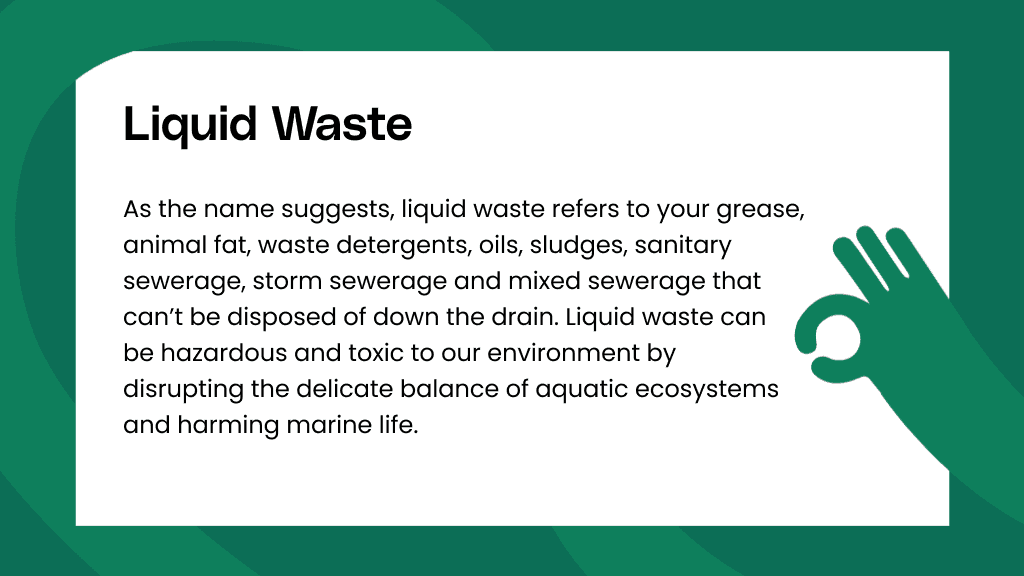Reclaim Waste - Truths
Reclaim Waste - Truths
Blog Article
The Basic Principles Of Reclaim Waste
Table of ContentsThe Basic Principles Of Reclaim Waste The Reclaim Waste IdeasThe Facts About Reclaim Waste Revealed4 Easy Facts About Reclaim Waste DescribedFascination About Reclaim Waste
Domestic sewage waste refers to the waste and items from a domestic septic container. The proper monitoring and disposal of domestic sewage waste call for fluid waste to be transferred to a sewer therapy plant where the proper techniques and tools are applied to cleanse and dispose of waste.
Commercial waste typically consists of potential dangers, such as combustible materials or a blend of fluid and strong waste products, and needs an advanced and in-depth disposal procedure. The disposal of industrial waste normally involves the filtering of waste prior to transport to ensure risk-free and appropriate disposal. Hazardous waste is created from byproducts and overflow of commercial procedures and manufacturing.
This type of waste can not utilize the very same sewer management transportation or processes as septic or industrial liquids. The industrial waste administration procedure calls for the examination and testing of liquid waste before it goes through the disposal process (liquid waste disposal). Drainage waste is the fluid waste that originates from runoff and excess stormwater in highly populated areas or cities
Runoff waste can cause contamination and flooding if not dealt with appropriately. Discover a lot more regarding drain cleaning and waste administration. Ensuring correct waste administration can avoid catastrophes and minimize environmental harm. Both people in household setups and experts in industrial or production industries can take advantage of recognizing the processes and regulations of fluid waste administration.
See This Report on Reclaim Waste
Contact PROS Providers today to find out about our waste administration and disposal solutions and the proper means to care for the fluid waste you produce.
(https://www.callupcontact.com/b/businessprofile/Reclaim_Waste/9368278)This so-called 'wastewater' is not just a vital source but, after therapy, will be released to our land, rivers or the ocean. Made use of water from toilets, showers, bathrooms, kitchen area sinks, laundries and commercial procedures is known as wastewater.

water utilized to cool equipment or clean plant and devices). Stormwater, a type of wastewater, is runoff that moves from agricultural and city areas such as roofing systems, parks, gardens, roads, paths and seamless gutters into stormwater drains pipes, after rainfall. Stormwater flows unattended directly to regional creeks or rivers, eventually reaching the sea.
The Best Strategy To Use For Reclaim Waste
In Queensland, a lot of wastewater is treated at sewage treatment plants. Wastewater is transferred from domestic or industrial websites via a system of sewage systems and pump stations, known as sewerage reticulation, to a sewer therapy plant.
The Division of Natural Resources encourages neighborhood federal governments about managing, operating and maintaining sewage systems and therapy plants. In unsewered areas, city governments might need householders to install specific or family sewer treatment systems to treat domestic wastewater from commodes, cooking areas, washrooms and washings. The Department of Natural Resources authorises the use of house systems when they are confirmed to be reliable.
In some new subdivisions, therapy of some stormwater to remove clutter, sand and gravel has actually begun using gross toxin traps. Wastewater therapy happens in 4 stages: Gets rid of solid issue.
Wastewater then streams right into big tanks where solids clear up and are eliminated as sludge. Oil and scum are skimmed from the surface area. Uses little living microorganisms called micro-organisms to break down and get rid of staying liquified wastes and fine particles. Micro-organisms and wastes are included in the sludge. Eliminates nitrogen and phosphorus nutrients that can create algal flowers in our waterways and endanger aquatic life.
Reclaim Waste Fundamentals Explained
Nutrient removal is not available in all sewer treatment plants because it needs costly specialist devices. It is ending up being more typical in Queensland. Clear fluid effluent generated after treatment may still consist of disease-causing micro-organisms. If this effluent is launched into waterways such as rivers or the sea, the micro-organisms will ultimately die out.

This normally suggests wastewater has to be dealt with or pollutants eliminated before it can be released to rivers. A lot of wastewater streams right into the sewage system. Under the Act, regional governments carry out approvals and permits for ecologically appropriate tasks (Ages) involving wastewater launches that Find Out More may have a local influence. The division administers approvals and permits to ERAs including wastewater releases that could have a regional or statewide influence.
The 4-Minute Rule for Reclaim Waste
Monitoring offers accurate details about water high quality and can validate that licence conditions are being met. The info obtained with tracking supplies the basis for making water top quality choices.
Report this page